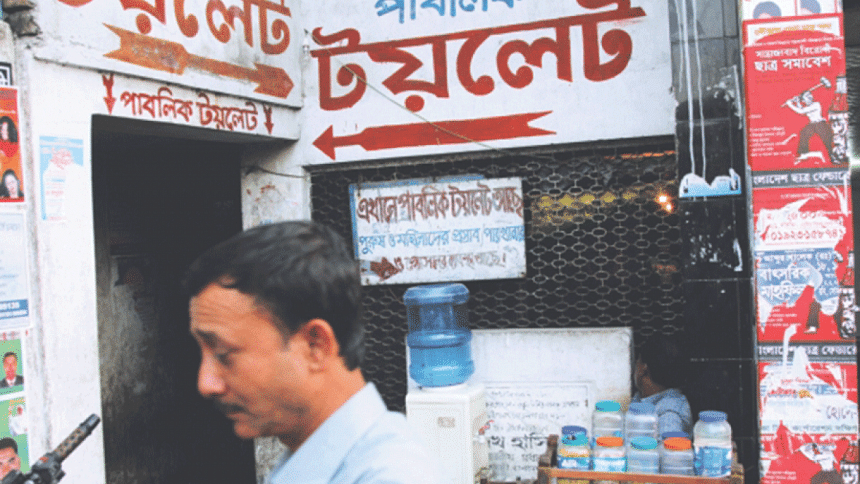Waiting for a miracle

The best thing about the building I come to work to six days a week is that it has reasonably clean (as in dry), separate toilets for women in each floor. It is a luxury that few women in this city can claim. I say "luxury" for what is a basic necessity because in Dhaka city (forget the rest of Bangladesh) having access to a reasonably useable toilet for women is a rarity. Sometimes it is a miracle.
Not that men have a great many options when they are in the streets. The number of public toilets is pathetically low (around one toilet per two lakh people), most of them so filthy and broken that only the extremely courageous few will venture into them. A study by ActionAid Bangladesh in association with UK Aid has found 90 percent of them to be unusable with most of them being unsafe and unhygienic.
For women going to a public toilet is usually unthinkable. They also do not have the option of just relieving themselves at some corner of the street—a garbage dump, open drain or under the footbridge—something their menfolk quite unabashedly feel entitled to. This is because shame is an integral part of being female. And because of shame women will hold their bladders for hours and hours until they have access to a clean toilet—which often means until they get home.
Women and girls therefore risk getting bladder and urinary tract infections (UTIs) and even kidney failure because they tend to drink far less water or liquid than they should. Conditions associated with dehydration—headaches, muscle cramps, lack of energy—are common amongst women and girls. The lack of useable public toilets makes going to a public event, or even carrying out everyday errands such as going to the bazar, activities accompanied by the anxiety of having to hold one's bladder for long periods of time.
While there have been recent initiatives by the city mayors and some NGOs to address the problem—introducing clean, safe, well-maintained or renovated toilets—they can only serve a fraction of the city's population. In slum areas especially, the lack of basic sanitation facilities makes life for its residents, especially the women, who often must wait until darkness before relieving themselves, even more miserable. Slum-dwellers use open, makeshift latrines and latrine water often gets mixed with drinking water. The lack of sanitation also increases the risk of transmission of deadly diseases such as cholera, dysentery, hepatitis A, typhoid and polio, which affect everybody—women, men and children.
It is hard to understand why, when crores of taka are spent in so-called beautification projects to show off to foreign dignitaries who will zoom by the main streets in a matter of seconds, the authorities have not paid much attention to one of the most basic public utilities of all time: toilets. There are around 47 operational public toilets in Dhaka city that has a population of at least 18 million.
What about the toilets inside buildings—in the workplace and in educational institutions? Do women and girls have access to clean toilets? The answer is no in most cases. Just think of the stink while passing the toilets in any public university, hospital or office. Although we have no data at hand, it is a well-known fact that women and girls will just not go to the toilets available in their place of work or learning because they lack basic sanitation.
There is an unexplained apathy towards keeping toilets clean. Those who have had the privilege to use the washroom of Dhaka's international airport will be familiar with the shock of finding stalls without locks, the floors wet because of a broken tap, and the basins blood red—stained with betel leaf expulsions from attendants. It is the same in most public buildings where there are apparently people employed to keep the toilets "clean" but who are either too disgruntled or too lazy to bother. Ensuring cleanliness is just not a priority.
So how would life change for people if they had access to clean, safe, usable toilets in the city? It would mean women and girls drinking more water and being spared the suffering associated with UTIs, not to mention the cost of doctor visits and medication. Women going to work and girls and women going to school or university would not have to worry about whether they will be able to wait until they reach home. Many diseases are related to poor hygiene and sanitation in public toilets which women and girls are sometimes compelled to use and this could be avoided if they were properly maintained by the authorities.
Going from point A to point B in Dhaka city has become a major challenge thanks to the hours of choking traffic that every city traveller must consider a daily hazard. Paradoxically, no matter how slow the traffic and how congested the city, more and more people, especially women, have to go out of their homes—to work, to earn, to buy and to socialise. Thus the availability of clean, safe public toilets is directly related to the quality of life of the people of this city. This means ensuring that there are clean restrooms in all public spaces—whether they are government establishments, public spaces such as shopping malls, marketplaces, thoroughfares and so on.
For women, having access to a clean, safe washroom when they step outside their homes would certainly be something to celebrate.
Aasha Mehreen Amin is Deputy Editor, Editorial and Opinion, The Daily Star.





Comments